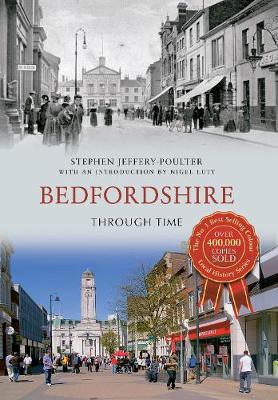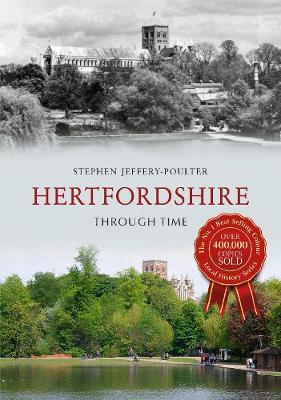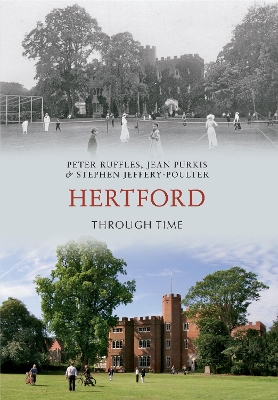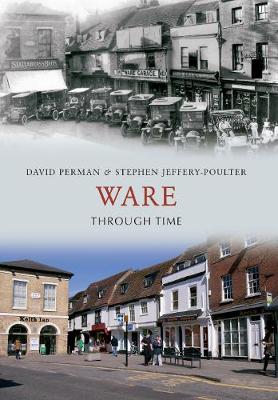Through Time
5 total works
Bedfordshire Through Time contains delightful period photographs of the towns and villages in this rural county. These images have been sourced mainly from the Sandy Chrystal postcard collection held by Bedfordshire & Luton Archives & Records Service - many being published for the first time. The contrasting modern colour pictures provide accessible and interesting insights into the many changes that have taken place over decades. The book also features extracts from a range of guidebooks and historical publications by authors such as journalist Arthur Mee and historian C. Gore Chambers, which appeared in the first fifty years of the last century when the original pictures were taken. While the major towns of Luton and Bedford have suffered from modernisation, most of this county's heritage has been left largely untouched for us to enjoy today.
It was in Hertfordshire, at Berkhamsted, that the English surrendered to William the Conqueror in 1066 - a turning point in the story of the kingdom. Ever since, the evolution of Hertfordshire has been influenced by the crown and capital. Proximity to London enabled its characteristic market towns to develop - to supply the inhabitants of the city with produce, and to provide sustenance and lodgings for those travelling to and from the provinces. This of course included the monarch, for as well as the royal residence at Berkhamsted there was a royal staging post at King's Langley. In more recent years, this close relationship has proved both a blessing and a curse. The level of urban development in Hertfordshire has rocketed as commuting has become the norm. However, this in turn led to the construction of the world's first garden city - Letchworth - putting the county at the vanguard of revolutionary social development. Furthermore, its unique position and character have also put it at the centre of popular culture, with Hertfordshire providing the setting for novels by Austen and Orwell, and more recently for blockbuster films such as Star Wars and Harry Potter, at the county's famous Elstree and Leavesden studios.
Hertford Through Time
by Peter Ruffles, Jean Purkis, and Stephen Jeffery-Poulter
Published 15 August 2011
Located in the heart of the Home Counties, Hertford has retained its identity as the administrative capital of 'The Shire of Hertford' for 1,000 years and yet has managed to remain a small, almost 'self-sufficient' town. The arable land surrounding Hertford led to the creation of its staple industry of brewing, with mills and maltings dominating the sky-line alongside civic buildings and private homes when many of the early photographs in this book were taken over a century ago. The book contains period photographs, many being published here for the very first time, which have mainly been sourced from Hertford Museum's extensive archive. The contrasting illustrations provide an accessible and interesting way of seeing the extraordinary changes that have taken place in this charming and historic market town over a century or more of evolution, expansion and re-development.
Having grown up as a small Roman settlement where Ermine Street crossed the River Lea, Ware came into its own in the Middle Ages as an important stopping place on the Old North Road to and from London. The booming inn trade was boosted by the Great Bed of Ware, mentioned by Shakespeare among others. This was replaced by a major new industry - the making of malt for the brewing industry - particularly brown malt that was used to make porter. The modern town still boasts a wealth of old buildings as well as the charming riverside gazebos which have recently been restored.
The book contains over 90 period pictures which have been sourced from Ware Museum's image archive. The contrasting modern colour images provide an accessible and interesting way of seeing the many changes that have taken place in this attractive and historic town over decades of evolution, expansion and re-development.
The book contains over 90 period pictures which have been sourced from Ware Museum's image archive. The contrasting modern colour images provide an accessible and interesting way of seeing the many changes that have taken place in this attractive and historic town over decades of evolution, expansion and re-development.
Hoddesdon & Broxbourne Through Time
by David Dent, Sue Garside, and Stephen Jeffery-Poulter
Published 15 October 2010
Hoddesdon really came into its own between the sixteenth and mid nineteenth centuries as a coaching town providing a welcome stopping place for travellers from London setting out on the Old North Road. Broxbourne, just to the south, was a smaller and more rural settlement focused around the church and manor house until the coming ofthe railway in 1840 began the process of gradual suburbanisation that has continued ever since. The contrasting illustrations provide an accessible and interesting way of seeing the extraordinary changes that have taken place in the two towns over a century or more of evolution, expansion and re-development. The period photos, the majority of which are being published for the very first time, have mainly been sourced from Lowewood Museum's extensive archive.




